*Hi friends! @dexterdev is back. This time I am attending a conference at IISc, Bangalore and thought I will write about a topic which was presented here by two speakers (one of them is my supervisor). The topic was about Antimicrobial peptides and its synthetic counterparts. This article is not very technical, so anyone can read it. Let me begin!*
---
Have you heard of SUPERBUGS? Some of you might be knowing that bacterias are developing more and more resistance against the [antibiotics](https://en.wikipedia.org/wiki/Antibiotics). A superbug is a bacteria which has acquired a great resistance against any antibiotics. And this is a scary situation for human beings! Below is a video from youtube, which was a part of this [research work](http://science.sciencemag.org/content/353/6304/1147.full).
https://www.youtube.com/watch?v=plVk4NVIUh8
[Video Source](https://www.youtube.com/watch?v=plVk4NVIUh8)
The above video shows sections of regions with increasing concentration of antibiotics. Bacteria starts multiplying from the section with no antibiotics. In the later regions bacteria gets confronted with antibiotics and few of the bacterial strains gets resistant against them and propagates towards later stages with higher concentration of antibiotics. It should be noted that if the concentration change in antibiotics is very abrupt from 0 to a high value, bacterias don't survive. But if we allow a gradient in concentration levels of antibiotics, bacteria gets adapted to the antibiotics and becomes resistant via the mutations which are acquired by certain bacterial strains.
It is known that bacterias are evolving very fast and devising mechanisms via mutations to combat antibiotics. ***We humans are falling back in devising antibiotics against bacteria.*** There is a clear decrease in the number of approved antibiotic medicines in US.
https://www.pharmaceutical-journal.com/files/rps-pjonline/Number_of_antibiotics.png
[Image Source](https://www.pharmaceutical-journal.com/files/rps-pjonline/Number_of_antibiotics.png)
The problem of antibiotic resistance is a very severe in developing nations like India. For example the hospital waste is not treated properly in India, which gives bacterias a great opportunity to gain resistance against the antibiotics.(A related News [article here](http://www.thehindu.com/todays-paper/tp-national/tp-otherstates/notice-to-4-states-over-biomedical-waste-disposal/article20462837.ece)) Also in subcontinent, the usage of antibiotics is sometimes not carefully administered. People at times stop the full course of antibiotics in between, once they feel better. This also gives bacteria great chance to develop resistance against antibiotics.

Below is a timeline which shows the introduction of antibiotic and when the bacterial resistance was observed.[Image from [Ref](https://www.nature.com/articles/nchembio.2007.24)]
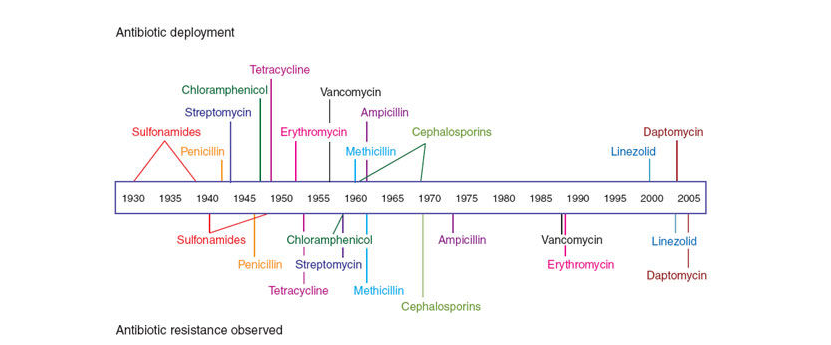
So in general, it is observed that the rate at which bacteria acquires antibiotic resistance is accelerating.
### What can humans do against SUPERBUGS?
***AMPs***
One thing which researchers are looking into is to alternate systems like [Antimicrobial peptides](https://en.wikipedia.org/wiki/Antimicrobial_peptides). The mechanism of action of Antimicrobial peptides (AMP) is very simple and different when comparing with antibiotics. While antibiotic small molecules interact mostly with the enzyme machinery inside the cell and halts its operation thereby killing bacteria, the action of AMPs are purely mechanistic in nature and targets the bacterial membrane.
> ***A detour to understand cell membranes***
>
> As you might know, every living cells have a [membrane](https://en.wikipedia.org/wiki/Cell_membrane).
>The below figure is taken from [here](https://en.wikipedia.org/wiki/Cell_membrane#/media/File:Cell_membrane_detailed_diagram_4.svg).
> 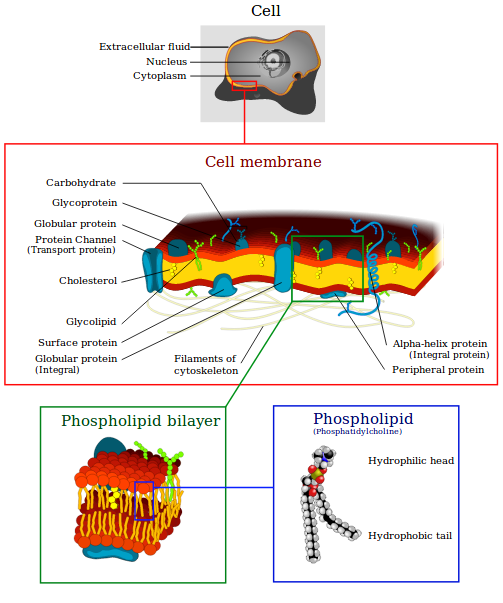
>
> The key point here is that lipid membrane composition of bacterial membrane and host cell membrane (hosts like humans) are very different. The below figure illustrates it.
>
>
> 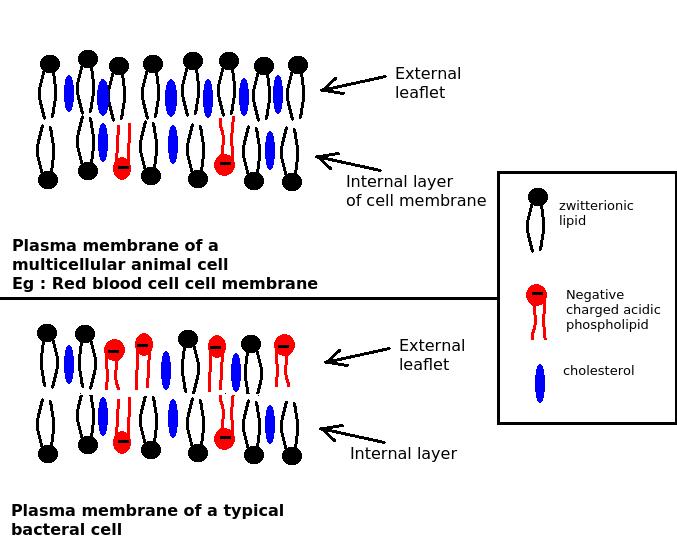
>[Note: In the above cartoon illustration, proteins are not shown. All realistic membranes have proteins associated with them. For now this point is not very relevant.]
From the above figure it is very clear that the bacterial membrane has more negatively charged head groups in the lipids. This particular feature is exploited by the AMPs.
Antimicrobial peptides (AMPs) are an important part of innate immune system of any multicellular organism. Below is a representation of a AMP called magainin II [Image adapted from this [paper](http://onlinelibrary.wiley.com/doi/10.1002/bip.20970/abstract)]:
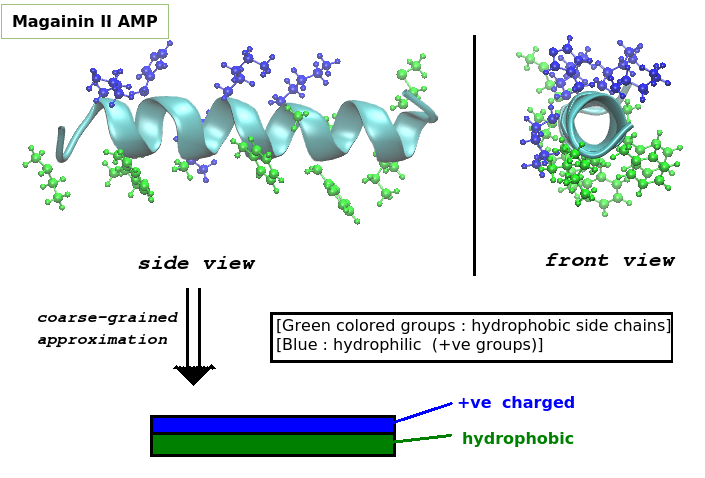
***How do AMPs differentiate bacterial membranes from host membrane?***
If you see the structure of this AMP, it is like a rod with one half surface lengthwise positively charges and the other side hydrophobic (naively water repelling). This asymmetry plays a great role in AMP's ability to
- first selectively differentiate between bacterial membrane(more negative charged) and other cell membranes.
- secondly to destroy bacterial membrane
From the figure below[adapted from [Ref](https://www.hindawi.com/journals/bmri/2014/867381/)], you can see that from where the selectivity arises towards bacterial membrane for AMPs.
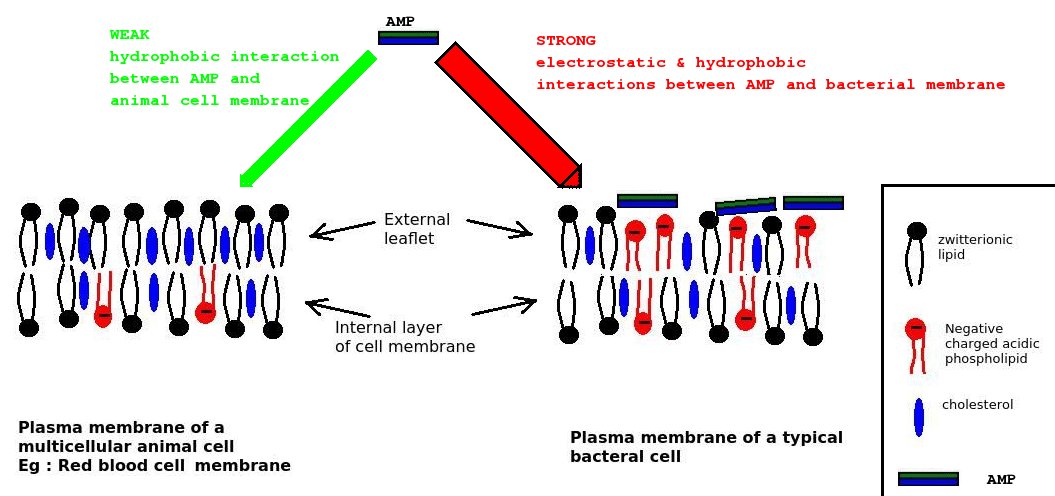
The above figure is so simple to understand for anyone. See there are more negatively charged head-groups on bacterial membranes. Electrostatic interactions here are between negatively charged lipid head groups and positively charged part of AMPs. I assume that you know opposite charges attract. This leads to an attraction from AMP-postively charged parts. So AMPs get stuck to membrane. Now we know that the lipid bilayers have hydrophilic head groups and hydrophobic tails. To destroy the membrane the AMPs must get inside of membrane. Now the AMPs which are attached to head-groups can also interact with tail groups, when occasionally tails get exposed. At those events AMPs get interacted with tail-groups and get inside membrane. Now there is a tug of war happening inside lipid, because the AMP also has charged hydrophilic region which repels with tail-groups of lipids, which ends up in destroying membranes.
***Let us see how AMP disrupts bacterial membrane***
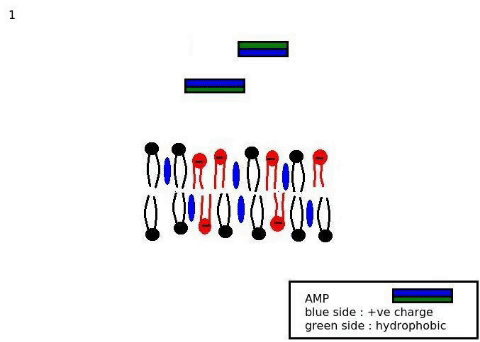
The above gif is a cartoon style illustration by the way. So please please take it with a pinch of salt. But for a popular science article this will do I guess. :)
### But Why AMPs are not a practical solution?
There are few reasons why AMPs cannot be used practically :
- One is that peptides easliy degrade
- Secondly it is very costly to manufacture them
### Alternative Solution : Synthetic polymers with AMP properties
So because of the above mentioned reasons, researchers started looking into synthesizing synthetic mimics of AMPs, which are more stable and having similar properties. For example : arylamide oligomers. Understanding the interaction of these molecules with membranes is a hard task. So people use [MD simulations](https://en.wikipedia.org/wiki/Molecular_dynamics) to zoom into the mechanisms.
Let us hope that AMPs and their synthetic counterparts will help stop superbugs to an extent therby saving many lives. I will stop here for now.
#### References :
[Thomas Ebenhan et al : Antimicrobial Peptides: Their Role as Infection-Selective Tracers for Molecular Imaging](https://www.hindawi.com/journals/bmri/2014/867381/)
[Som et al : Synthetic mimics of antimicrobial peptides](http://onlinelibrary.wiley.com/doi/10.1002/bip.20970/abstract)
---
***Hi,***
***I am Devanand from Chennai, India. And my steemit handle is @dexterdev***
***Do you like my posts? In case you have questions, please shoot those in comments.***
***Also, Resteem and Upvote if you like these posts!***
***If you would like to see any improvements, please tell me in comments.***
***Follow me for latest exciting articles! :)***
*[All images without image sources are my creations :)]*

 hiveblocks
hiveblocks